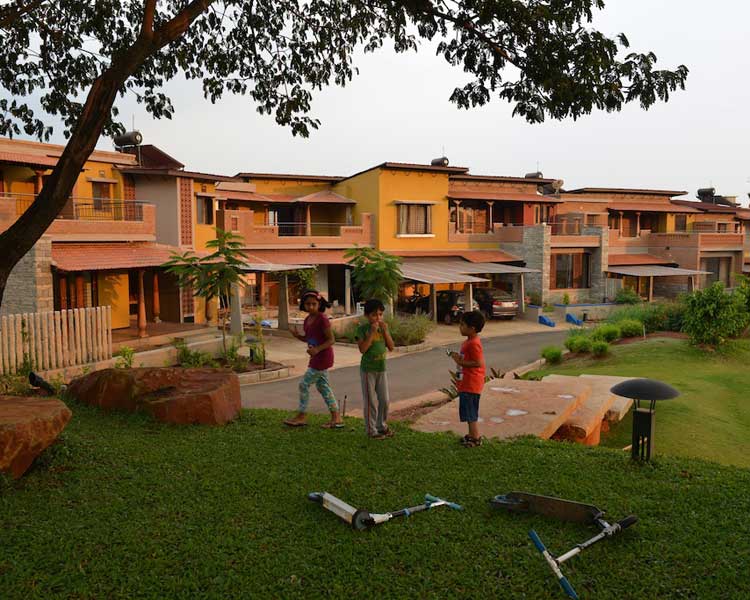The aroma of the tempering of sambhar drifts up through the courtyard between the houses and in through the windows. Elsewhere the sound of dishes being washed merges with the sound of the sprinklers watering the garden. The stillness punctuated with the whistling of birds and snatches of conversation in the distance. Time, is marked by the sights and smells in the community, apart from the shadows of the sun and direction of the breeze. The early morning travails of a young flutist, her progress monitored by all – especially the elderly lady catching a bit of the warm sun and collecting flowers for her daily puja in the park. Children coming home from school in the afternoon, their chatter signalling lunch. The garden and harvest the subject of many a discussion as one walks around in the evening. From protecting the mangoes as they ripen, indulgently giving way to some kids “stealing” the raw ones. Limes being harvested to make pickle, raw bananas being shared as “bajji” with hot tea, in the park. The comfort of borrowing that onion you have run out of for dinner or if lucky, a generous friend offering some of her dinner to share. And not forget the silvery moonlit nights, making it surreal.

When left to their own, people instinctively build homes near each other, out of necessities like sharing resources, safety and the simple need to be near each other. Organically developed settlements are a result of this coupled with a response to the natural topography. Boundaries tangible and intangible developing over time. In the design of a housing communities in the city, the choice or challenge is not just between high or low rise, but more importantly about how the transitions happen. How does one juxtapose privacy with interactive spaces? Would the sounds and smells create more conflict that camaraderie, in a different context? How close is too close?
The intuitiveness of sharing resources, the need for negotiation and involvement rather than oversimplified, convenient systems that do not challenge our ideas on sharing and community- the room for failure and forgiveness. These are processes and values which we need to rediscover – not just in the romantic sense but also in the practical – if we are to sustain ourselves, socially and environmentally.
In planning a cluster, the scenes of how it may be used, play out in one’s mind and the sheer joy of the mathematics of the process – where every foot and metre is a subtle exercise in scale and proportion, being composed like a poem or a song, along with the natural topography and feel of the land. The shared open space and its size becomes the determining factor of how the homes around the cluster will pan out. The individual yards, being worked around this, to visually expand the common space. The services like water and electricity, and treatment of sewage, can be worked very efficiently in this format. If houses are built around a park instead of along a street, it is advantageous in multiple ways. The hard surfaces to access the house can be reduced. By the sizing of the open space, the buildings shade the park reducing the ambient temperature within the cluster, especially if it is densely planted.


Speaking of sizing, I have worked with the smallest cluster space being 18mx 18m or 60feetx 60 feet. Where the ambience is one of a courtyard, with 9-10 homes around it. The treatment of the courtyard is best with a single element, like a tree or a waterbody, to give it a sense on oneness. A mid-sized cluster space would be 25m x 25 m, with more homes around and the space in the centre being used for play and community activities. Larger spaces become playgrounds, where the homes are far enough to avoid windows being broken by enthusiastic cricket players hitting a six. Street planning which also breaks the monotony of a straight line, by introducing small wider clearings intermittently, which may become wayside sitting places, especially for the elderly. Transitions to and through these clusters, become character defining elements. These explorations have been in the context of low and mid-rise development, but the possibilities exist in the high rise too.
If one can think alternatively that the shared spaces are as important as the personal, and need a joint caring, in terms of time and priority, we may see our neighborhoods changing.




lovely!
So proud to have been associated in some way with this community
Wonderful & I could visualise Malhar in the picture…picture perfect!
so so so beautiful and truly echoes my sentiments and experience of living in malhar!